Ye Hu
Sid
Resilient Vehicular Communications under Imperfect Channel State Information
May 03, 2025Abstract:Cellular vehicle-to-everything (C-V2X) networks provide a promising solution to improve road safety and traffic efficiency. One key challenge in such systems lies in meeting quality-of-service (QoS) requirements of vehicular communication links given limited network resources, particularly under imperfect channel state information (CSI) conditions caused by the highly dynamic environment. In this paper, a novel two-phase framework is proposed to instill resilience into C-V2X networks under unknown imperfect CSI. The resilience of the C-V2X network is defined, quantified, and optimized the first time through two principal dimensions: absorption phase and adaptation phase. Specifically, the probability distribution function (PDF) of the imperfect CSI is estimated during the absorption phase through dedicated absorption power scheme and resource block (RB) assignment. The estimated PDF is further used to analyze the interplay and reveal the tradeoff between these two phases. Then, a novel metric named hazard rate (HR) is exploited to balance the C-V2X network's prioritization on absorption and adaptation. Finally, the estimated PDF is exploited in the adaptation phase to recover the network's QoS through a real-time power allocation optimization. Simulation results demonstrate the superior capability of the proposed framework in sustaining the QoS of the C-V2X network under imperfect CSI. Specifically, in the adaptation phase, the proposed design reduces the vehicle-tovehicle (V2V) delay that exceeds QoS requirement by 35% and 56%, and improves the average vehicle-to-infrastructure (V2I) throughput by 14% and 16% compared to the model-based and data-driven benchmarks, respectively, without compromising the network's QoS in the absorption phase.
RIS-Assisted Passive Localization (RAPL): An Efficient Zero-Overhead Framework Using Conditional Sample Mean
Mar 25, 2025Abstract:Reconfigurable Intelligent Surface (RIS) has been recognized as a promising solution for enhancing localization accuracy. Traditional RIS-based localization methods typically rely on prior channel knowledge, beam scanning, and pilot-based assistance. These approaches often result in substantial energy and computational overhead, and require real-time coordination between the base station (BS) and the RIS. To address these challenges, in this work, we move beyond conventional methods and introduce a novel data-driven, multiple RISs-assisted passive localization approach (RAPL). The proposed method includes two stages, the angle-of-directions (AoDs) between the RISs and the user is estimated by using the conditional sample mean in the first stage, and then the user's position is determined based on the estimated multiple AoD pairs in the second stage. This approach only utilizes the existing communication signals between the user and the BS, relying solely on the measurement of received signal power at each BS antenna for a set of randomly generated phase shifts across all RISs. Moreover, by obviating the need for real-time RIS phase shift optimization or user-to-BS pilot transmissions, the method introduces no additional communication overhead, making it highly suitable for deployment in real-world networks. The proposed scheme is then extended to multi-RIS scenarios considering both parallel and cascaded RIS topologies. Numerical results show that the proposed RAPL improves localization accuracy while significantly reducing energy and signaling overhead compared to conventional methods.
Latency Optimization in LEO Satellite Communications with Hybrid Beam Pattern and Interference Control
Nov 14, 2024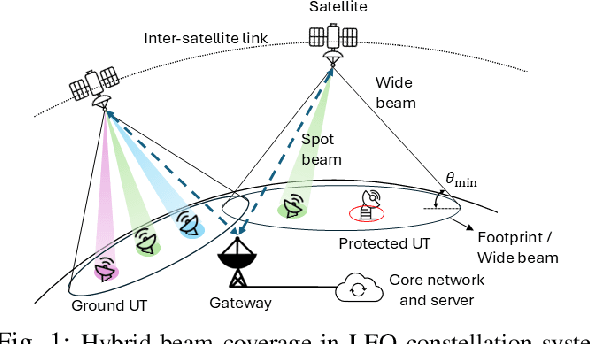
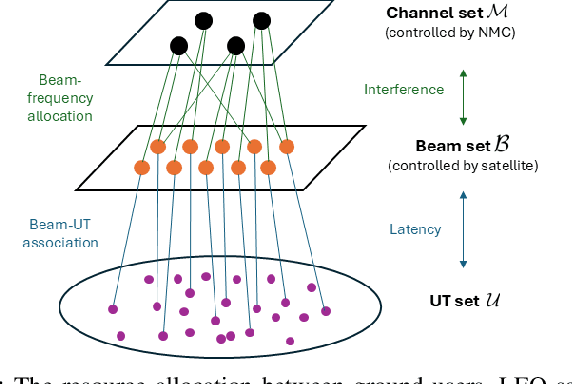
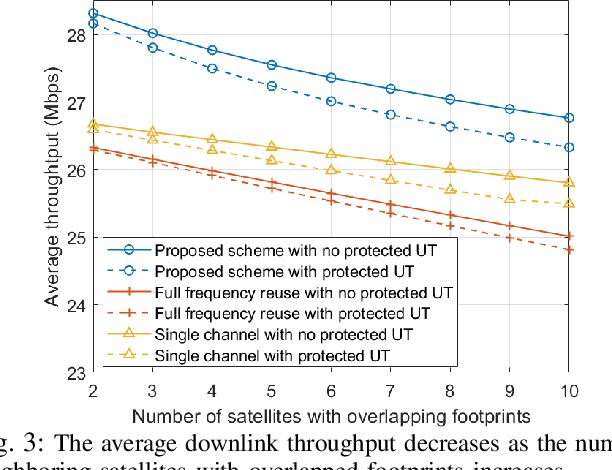
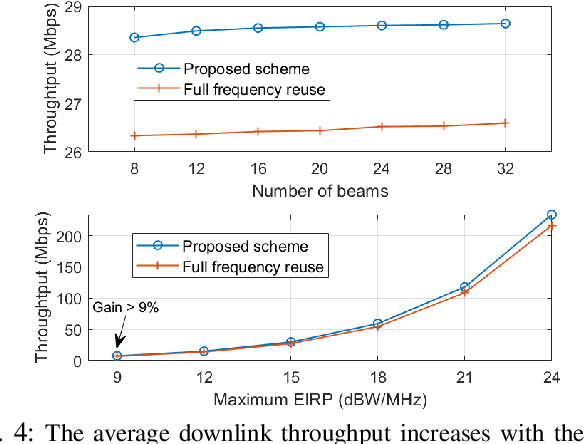
Abstract:The rapid advancement of low Earth orbit (LEO) satellite communication systems has significantly enhanced global connectivity, offering high-capacity, low-latency services crucial for next-generation applications. However, the dense configuration of LEO constellations poses challenges in resource allocation optimization and interference management, complicating coexistence with other communication systems. To address these limitations, this paper proposes a novel framework for optimizing the beam scheduling and resource allocation in multi-beam LEO systems. To satisfy the uneven terrestrial traffic demand, a hybrid beam pattern is employed to enhance the downlink quality of service and minimize the transmission latency from LEO satellites to ground user terminals. Additionally, a dynamic co-channel interference (CCI) control mechanism is developed to mitigate inter-beam interference within the LEO constellation and limit cross-system interference affecting protected users from other networks. The problem of user-beam-frequency allocation with power optimization is formulated as a mixed-integer dynamic programming model and solved using a low-complexity neural network-based graph generation algorithm. Simulation results show that the proposed approach outperforms the baseline methods of full frequency reuse and single-channel transmission, and highlights the potential for further performance improvement with multi-user transmissions.
Hyperdimensional Computing Empowered Federated Foundation Model over Wireless Networks for Metaverse
Aug 26, 2024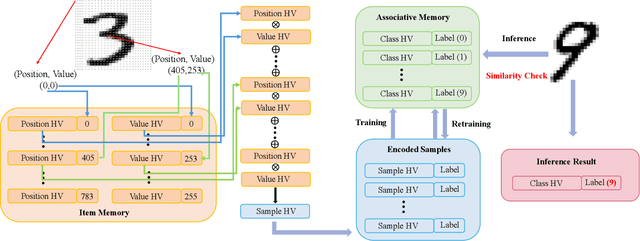

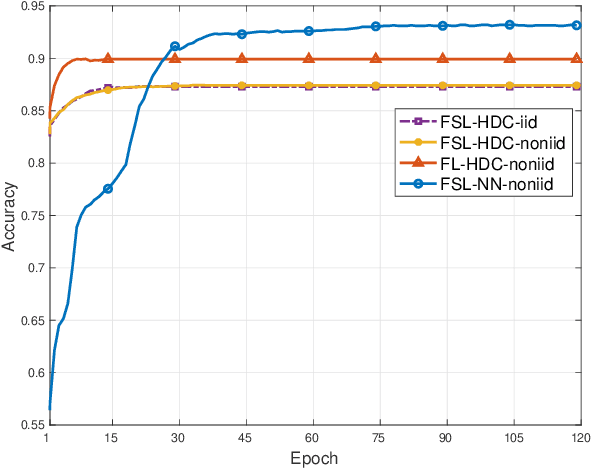
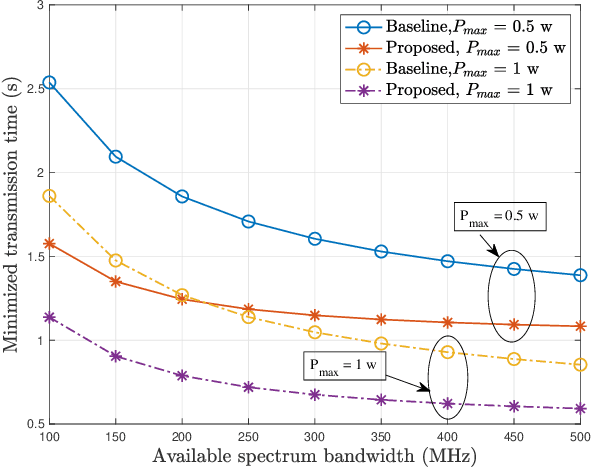
Abstract:The Metaverse, a burgeoning collective virtual space merging augmented reality and persistent virtual worlds, necessitates advanced artificial intelligence (AI) and communication technologies to support immersive and interactive experiences. Federated learning (FL) has emerged as a promising technique for collaboratively training AI models while preserving data privacy. However, FL faces challenges such as high communication overhead and substantial computational demands, particularly for neural network (NN) models. To address these issues, we propose an integrated federated split learning and hyperdimensional computing (FSL-HDC) framework for emerging foundation models. This novel approach reduces communication costs, computation load, and privacy risks, making it particularly suitable for resource-constrained edge devices in the Metaverse, ensuring real-time responsive interactions. Additionally, we introduce an optimization algorithm that concurrently optimizes transmission power and bandwidth to minimize the maximum transmission time among all users to the server. The simulation results based on the MNIST dataset indicate that FSL-HDC achieves an accuracy rate of approximately 87.5%, which is slightly lower than that of FL-HDC. However, FSL-HDC exhibits a significantly faster convergence speed, approximately 3.733x that of FSL-NN, and demonstrates robustness to non-IID data distributions. Moreover, our proposed optimization algorithm can reduce the maximum transmission time by up to 64% compared with the baseline.
The Llama 3 Herd of Models
Jul 31, 2024Abstract:Modern artificial intelligence (AI) systems are powered by foundation models. This paper presents a new set of foundation models, called Llama 3. It is a herd of language models that natively support multilinguality, coding, reasoning, and tool usage. Our largest model is a dense Transformer with 405B parameters and a context window of up to 128K tokens. This paper presents an extensive empirical evaluation of Llama 3. We find that Llama 3 delivers comparable quality to leading language models such as GPT-4 on a plethora of tasks. We publicly release Llama 3, including pre-trained and post-trained versions of the 405B parameter language model and our Llama Guard 3 model for input and output safety. The paper also presents the results of experiments in which we integrate image, video, and speech capabilities into Llama 3 via a compositional approach. We observe this approach performs competitively with the state-of-the-art on image, video, and speech recognition tasks. The resulting models are not yet being broadly released as they are still under development.
Jointly Optimizing Terahertz based Sensing and Communications in Vehicular Networks: A Dynamic Graph Neural Network Approach
Mar 17, 2024



Abstract:In this paper, the problem of vehicle service mode selection (sensing, communication, or both) and vehicle connections within terahertz (THz) enabled joint sensing and communications over vehicular networks is studied. The considered network consists of several service provider vehicles (SPVs) that can provide: 1) only sensing service, 2) only communication service, and 3) both services, sensing service request vehicles, and communication service request vehicles. Based on the vehicle network topology and their service accessibility, SPVs strategically select service request vehicles to provide sensing, communication, or both services. This problem is formulated as an optimization problem, aiming to maximize the number of successfully served vehicles by jointly determining the service mode of each SPV and its associated vehicles. To solve this problem, we propose a dynamic graph neural network (GNN) model that selects appropriate graph information aggregation functions according to the vehicle network topology, thus extracting more vehicle network information compared to traditional static GNNs that use fixed aggregation functions for different vehicle network topologies. Using the extracted vehicle network information, the service mode of each SPV and its served service request vehicles will be determined. Simulation results show that the proposed dynamic GNN based method can improve the number of successfully served vehicles by up to 17% and 28% compared to a GNN based algorithm with a fixed neural network model and a conventional optimization algorithm without using GNNs.
Probabilistic Semantic Communication over Wireless Networks with Rate Splitting
Mar 01, 2024Abstract:In this paper, the problem of joint transmission and computation resource allocation for probabilistic semantic communication (PSC) system with rate splitting multiple access (RSMA) is investigated. In the considered model, the base station (BS) needs to transmit a large amount of data to multiple users with RSMA. Due to limited communication resources, the BS is required to utilize semantic communication techniques to compress the large-sized data. The semantic communication is enabled by shared probability graphs between the BS and the users. The probability graph can be used to further compress the transmission data at the BS, while the received compressed semantic information can be recovered through using the same shared probability graph at each user side. The semantic information compression progress consumes additional computation power at the BS, which inevitably decreases the transmission power due to limited total power budget. Considering both the effect of semantic compression ratio and computation power, the semantic rate expression for RSMA is first obtained. Then, based on the obtained rate expression, an optimization problem is formulated with the aim of maximizing the sum of semantic rates of all users under total power, semantic compression ratio, and rate allocation constraints. To tackle this problem, an iterative algorithm is proposed, where the rate allocation and transmit beamforming design subproblem is solved using a successive convex approximation method, and the semantic compression ratio subproblem is addressed using a greedy algorithm. Numerical results validate the effectiveness of the proposed scheme.
Collaborative Reinforcement Learning Based Unmanned Aerial Vehicle (UAV) Trajectory Design for 3D UAV Tracking
Jan 22, 2024Abstract:In this paper, the problem of using one active unmanned aerial vehicle (UAV) and four passive UAVs to localize a 3D target UAV in real time is investigated. In the considered model, each passive UAV receives reflection signals from the target UAV, which are initially transmitted by the active UAV. The received reflection signals allow each passive UAV to estimate the signal transmission distance which will be transmitted to a base station (BS) for the estimation of the position of the target UAV. Due to the movement of the target UAV, each active/passive UAV must optimize its trajectory to continuously localize the target UAV. Meanwhile, since the accuracy of the distance estimation depends on the signal-to-noise ratio of the transmission signals, the active UAV must optimize its transmit power. This problem is formulated as an optimization problem whose goal is to jointly optimize the transmit power of the active UAV and trajectories of both active and passive UAVs so as to maximize the target UAV positioning accuracy. To solve this problem, a Z function decomposition based reinforcement learning (ZD-RL) method is proposed. Compared to value function decomposition based RL (VD-RL), the proposed method can find the probability distribution of the sum of future rewards to accurately estimate the expected value of the sum of future rewards thus finding better transmit power of the active UAV and trajectories for both active and passive UAVs and improving target UAV positioning accuracy. Simulation results show that the proposed ZD-RL method can reduce the positioning errors by up to 39.4% and 64.6%, compared to VD-RL and independent deep RL methods, respectively.
Joint User Scheduling and Computing Resource Allocation Optimization in Asynchronous Mobile Edge Computing Networks
Jan 21, 2024Abstract:In this paper, the problem of joint user scheduling and computing resource allocation in asynchronous mobile edge computing (MEC) networks is studied. In such networks, edge devices will offload their computational tasks to an MEC server, using the energy they harvest from this server. To get their tasks processed on time using the harvested energy, edge devices will strategically schedule their task offloading, and compete for the computational resource at the MEC server. Then, the MEC server will execute these tasks asynchronously based on the arrival of the tasks. This joint user scheduling, time and computation resource allocation problem is posed as an optimization framework whose goal is to find the optimal scheduling and allocation strategy that minimizes the energy consumption of these mobile computing tasks. To solve this mixed-integer non-linear programming problem, the general benders decomposition method is adopted which decomposes the original problem into a primal problem and a master problem. Specifically, the primal problem is related to computation resource and time slot allocation, of which the optimal closed-form solution is obtained. The master problem regarding discrete user scheduling variables is constructed by adding optimality cuts or feasibility cuts according to whether the primal problem is feasible, which is a standard mixed-integer linear programming problem and can be efficiently solved. By iteratively solving the primal problem and master problem, the optimal scheduling and resource allocation scheme is obtained. Simulation results demonstrate that the proposed asynchronous computing framework reduces 87.17% energy consumption compared with conventional synchronous computing counterpart.
Semantic Information Extraction for Text Data with Probability Graph
Sep 16, 2023Abstract:In this paper, the problem of semantic information extraction for resource constrained text data transmission is studied. In the considered model, a sequence of text data need to be transmitted within a communication resource-constrained network, which only allows limited data transmission. Thus, at the transmitter, the original text data is extracted with natural language processing techniques. Then, the extracted semantic information is captured in a knowledge graph. An additional probability dimension is introduced in this graph to capture the importance of each information. This semantic information extraction problem is posed as an optimization framework whose goal is to extract most important semantic information for transmission. To find an optimal solution for this problem, a Floyd's algorithm based solution coupled with an efficient sorting mechanism is proposed. Numerical results testify the effectiveness of the proposed algorithm with regards to two novel performance metrics including semantic uncertainty and semantic similarity.
 Add to Chrome
Add to Chrome Add to Firefox
Add to Firefox Add to Edge
Add to Edge